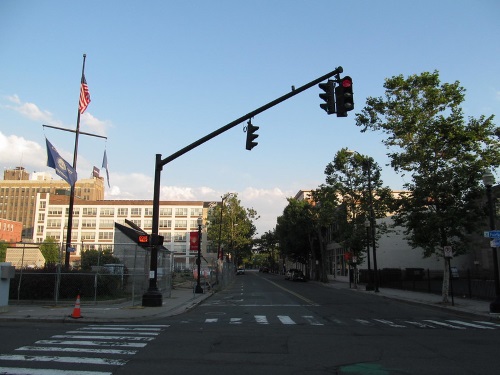The Connecticut Department of Transportation recently issued a 24-page report outlining key tactics and programs to increase pedestrian safety statewide as both national trends and state data points highlight the need to address pedestrian fatalities and injuries.
[Above photo of Bridgeport, CT, intersection by Doug Kerr.]
Nationally, pedestrian fatalities are increasing more than any other type of traffic fatality, according to data released by the National Highway Traffic Safety Administration. Meanwhile, in Connecticut over the past five years, the state averaged about 58 pedestrian fatalities annually – with preliminary 2020 crash data indicating 65 pedestrian fatalities occurred on state roadways.
“Far too many families have been impacted by a crash that resulted in a pedestrian fatality or serious injury,” said noted Joseph Giulietti, Connecticut DOT commissioner, in a statement. “[We] remain committed to working with our municipal partners to tackle the challenge of pedestrian safety, which will make our roadways safer for all that use them.”
Referencing NHTSA data, the Connect DOT said there has been a 53 percent increase in pedestrian deaths nationally between 2009 and 2018. The agency said there are several “significant factors” behind that spike in overall U.S. pedestrian fatalities including:
- An increasing number of people are choosing to walk and be active outside, increasing the number of pedestrians on the streets.
- An increased percentage of vehicles on the road are comprised of larger Sport Utility Vehicles and pick-up trucks, which can inflict more serious injuries to pedestrians.
- An increased use of smartphones, increasing the potential for distractions.
- Increased incidences of impaired driving and walking.
To counteract those trends, the Connecticut DOT’s report recommends what it calls a “four-pronged approach” to help reduce pedestrian risk and thereby increase safety:
- Reduce and better manage traffic speeds in areas with significant pedestrian activity.
- Implement safer roadway designs for crosswalks, intersections, and streets.
- Increase public awareness campaigns to promote safer, less risky pedestrian behaviors.
Align policies and programs that strengthen the state’s roadway safety program for motorists and non-motorists alike.

